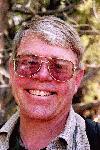|
Microwave heating is of interest in the processing of polycrystalline ceramic materials, primarily because powder compacts can be heated uniformly, but also because there is empirical evidence that microwave heating has some intrinsic effect on lattice dynamics that allows diffusion and solid-state reactions to occur more rapidly than when conventional, radiant heating is employed. In collaborative work with Prof. John Booske (Department of Electrical and Computer Engineering), we have been studying the physics of microwave-insulating ionic solid interactions. We have demonstrated unequivocally (Fig. 8) that the intrinsic "microwave effect" exists, that it affects, not the mobility or concentration of point defects allowing diffusion, but rather the driving force for chemical diffusion, specifically near interfaces (free surfaces, grain boundaries, etc.). As such, and borrowing from the plasma physics community, we describe the microwave effect as the "ponderomotive force of "pmf." We have additionally worked, too, to characterize the hierarchy of lattice-defect-based microwave absorption mechanisms.
Our microwave research is now turning towards application of the pmf, that is, identifying physical situations where enhanced chemical diffusion near interfaces or surfaces can prove a valuable asset for materials processing. Examples include "activation" of shallow-doped silicon and Si wafer bonding for MEMS applications. These new processing endeavors are pursued in collaboration, too, with Prof. Yogesh Gianchandani (Department of Electrical and Computer Engineering).

Figure 8: Schematic of experimental apparatus where pmf was isolated. A single mode waveguide was modified to be externally heated and the AC and DC ionic conductivities of pure and doped NaCl single crystals were measured as functions of the applied potential, temperature and pulsed microwave irradiation (no heat deposition by the microwave pulses). The enhanced conductivity seen for the specimen with the microwave irradiation scaled not as would a transport coefficient, but rather as a driving force.
Sample Publications:
Booske, J.H., R.F. Cooper and S.A. Freeman (1997). Microwave enhanced reaction kinetics in ceramics. Mater. Res. Innov., 1, 77-84. Download pdf
Freeman, S.A., J.H. Booske and R.F. Cooper (1998). Modeling and numerical simulations of microwave-induced ionic transport. J. Appl. Phys., 83, 5761-5772.Download pdf
Booske, J.H., R.F. Cooper, K. Ruffer and S.A. Freeman (2000). Measurements of internal temperature profiles in microwave-sintered ceramics using localized spinel-formation reactions. Proc. 7th Int'l. Conf. on Microwave and RF Heating.
Download pdf
|

